Where to go in Switzerland on a short trip: Alps, lakes, and cities
Switzerland is an extremely popular country for those planning multi-stop tours around Europe, yet very few potential first-time visitors actually know specifically where they want to go. Everyone seems to know that it has the most beautiful views of the Alps and some very impressive cities, but there are actually many misconceptions among casual trip planners, so I’d like to clear most of that up below. The places to visit in Switzerland are not obvious until you’ve been there yourself or done many hours of research, so the list below should be a short cut.
I get hundreds if not thousands of itinerary questions for people who are considering a Eurail trip around Europe, and most people just include the word “Switzerland” among a list of cities like Paris, Rome, and Berlin that they want to visit. So where in Switzerland should you go if you can only make a few stops at most? I’ll answer that question below.
Note: This article was expanded and updated in February, 2024.
Switzerland is about outdoor views rather than city visits
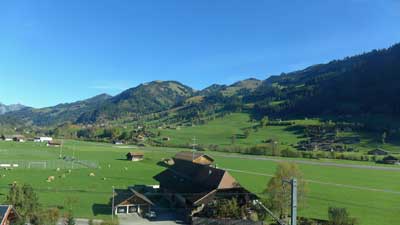
Geneva is a very famous city (though not for tourism reasons) on a lovely lake of the same name, but it’s also notoriously dull and lacking distinction. Rick Steves puts it well by saying that “Geneva is pleasantly situated on a lake, like Buffalo or Cleveland.” The point is, you don’t want to go to Geneva unless you’ve got something specific in mind that you want to see there.
Switzerland's cities in summary
Zurich – The largest city, very expensive, geared towards business travelers. It’s generally a pretty and very well-run city that you would enjoy if you visited, but it’s not nearly as interesting as the likes of Vienna, Munich, or of course Paris.
Geneva – Second largest city, in the French part of the country, no major sights. Again, if you visited you’d be very impressed by it and get some great photos, but it’s not worth your time unless you know someone there. There’s an impressive fountain in the lake and you can usually see it from the train as you go through the city, but it’s not really worth going there and staying more than an hour or so.
Basel – Bordering France and Germany, no major sights. It has the famous art market each year, and aside from that it’s even duller than the ones above. Again, if you visited you’d be impressed, but if you later compared photos with friends who went to the Lauterbrunnen Valley instead, you’d kick yourself for going to Basel.
Lausanne – Near Geneva in the French part of the country, very hilly, and certainly more interesting than Geneva.
Bern – The capital, compact, on a lovely river, some interesting sights and the best Swiss city to get a feel for the culture. Bern is fairly close to Interlaken (which we will discuss below) and it can be a great day trip from there, especially on a day where it is foggy and/or rainy in the mountains (and this happens a LOT).
How much time and which Swiss cities to visit?
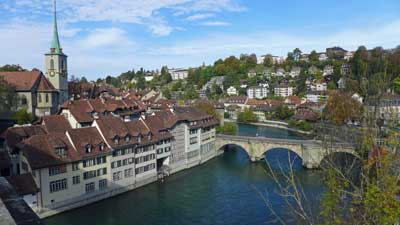
Many people (me included) don’t feel as if they’ve scratched the surface of a new country if they haven’t spent at least a day or two in the largest city. Zurich is certainly pleasant and a useful transit hub so spending one or two nights there wouldn’t be a major mistake. But Zurich isn’t even close to being a city like Paris, Rome, Berlin, Amsterdam, or even Vienna. If you skip it in favor of spending more time in the outdoors, you won’t be missing much.
The 2 Swiss places to focus on for short visits
Interlaken – If you want the best possible Alpine views and activities, head to the Interlaken area, which will be described in detail below.
Lucerne – The traditional Swiss tourist retreat, Lucerne is a small city with interesting culture and sights, that is gorgeously set on a lake with plenty of top activities surrounding it.
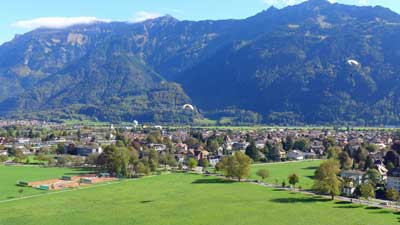
>>>Interlaken and Lucerne: Which to choose and how long to stay in each?
The article linked above will give you more details on which to choose and how long to spend in each place.
What about Zermatt for Alpine views?
Zermatt is a remote car-free village in southern Switzerland that is famous for being the place to see the Matterhorn mountain. It’s also a busy ski resort area, and aside from that, there isn’t much to see or do here. It’s on a private rail line, so it’s more complicated and usually more expensive to reach than Interlaken.
In other words, unless you’ve irrationally placed “Seeing the Matterhorn in person” on your so-called bucket list, skip Zermatt and head to Interlaken on a shorter visit. You won’t be sorry. If you already have enough time in your visit for the main sights around Interlaken and Lucerne and you want to also see the Matterhorn, then by all means go and you’ll enjoy it. There are quite a few other car-free villages in the Lauterbrunnen Valley near Interlaken, so they are not as novel in Switzerland as one might expect.
A weekend in Switzerland?
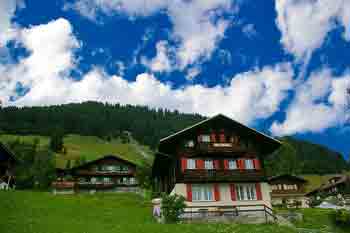
One challenge is that neither has an international airport so you’ll either be flying into Zurich or perhaps Geneva.
Train times from Zurich to Lucerne to Interlaken and back
- Zurich Airport to Lucerne: 1 hour 10 minutes by train
- Lucerne to Interlaken: 2 hours by train
- Interlaken to Zurich Airport: 2 hours 15 minutes by train
As you can see with the travel times above, Zurich Airport to Lucerne is a fairly short trip, but once you add Interlaken into the mix (even if you skip Lucerne) the travel time starts to add up for a weekend visit. With this in mind it’s probably best to just choose one of them and save the other one for another trip.
Lucerne is gorgeous, but the Lauterbrunnen Valley near Interlaken is really the star of the show, so I’d recommend going there first and doing Lucerne on another trip.
What about the Swiss Travel Pass?
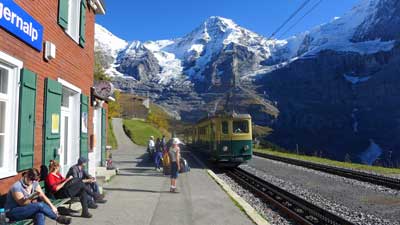
The bottom line is that if you are coming to Switzerland for at least 3 days and you want to take 2 or more of the amazing scenic rail journeys that the country is famous for, the travel pass is probably a good deal. It also provides 50% discounts on the Schilthorn cable car and 25% off the Jungfraujoch mountain railway. Both of those are quite expensive on their own, but extremely worthwhile, so the discount is helpful.
The Half Fare Card is probably a better deal for most people
The Swiss Travel Pass is a good deal for those who are going to be spending at least 2 or 3 days riding the rails and seeing Switzerland that way. But if you are mostly going to be focusing on Interlaken and Lucerne and the mountain sights, the Half Fare Card is the best option. For CHF120 (about US$134) you get the card that is good for 30 days and gives you a 50% discount on all trains, cable cars, mountain railways, and other sights and attractions. If you are doing either Schilthorn or Jungfraujoch, the Half Fare Card practically pays for itself with just one of those.
>>>Buy the Swiss Half Fare Card
Many people have questions about the Swiss Half Fare Card so I will explain it a bit here. You can actually buy half price train tickets for travel within Switzerland any time you want and you will see that option when you go to buy them online. The only thing is you have to have and present a valid Half Fare Card when you get on the train and are asked to see your ticket. In other words, you can buy a half fare train ticket today and buy a Half Fare Card just before you get on that train months in the future, and you are fine.
How and why visit the area around Interlaken
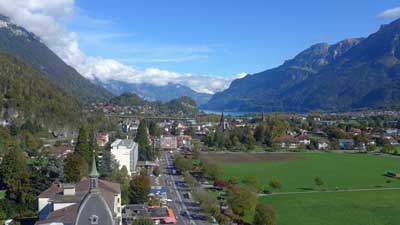
You can see everything discussed below by actually staying in a hotel in Interlaken, but it’s not the Alpine experience that you get if you stay in one of the small villages nearby. You can reach those villages in 20 to 40 minutes from the Interlaken Ost (East) train station, and it’s much easier than it sounds.
The 3 best places to stay to visit the Swiss Alps
Lauterbrunnen – A private train line runs from Interlaken Ost station to the end of its line in Lauterbrunnen. There’s a lovely waterfall here and great hiking trails, but you should probably only stay here if you can’t get to one of the villages mentioned just below. It’s a great little transit hub and it’s definitely gorgeous, so it can be worth a night if you’ve got one to spare.
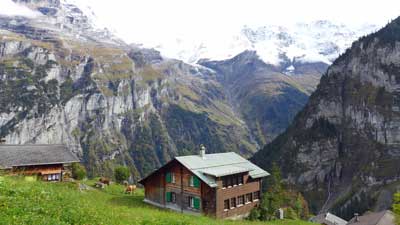
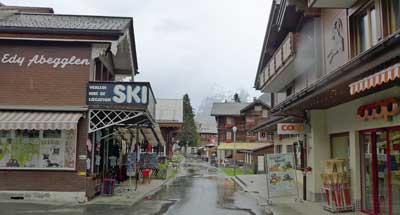
Where to stay in Interlaken and the Lauterbrunnen Valley (with pics)
I get so many questions about where to stay in the Interlaken area that I decided to write a longer version of it and load it with huge photos so readers can get a better feel for each option. I also included recommendations for affordable and well-located photos in each area.
>>>Where to stay in Interlaken and the Lauterbrunnen Valley New for 2024!
The unforgettable things to see here (if the weather is decent)
Schilthorn observation deck and restaurant
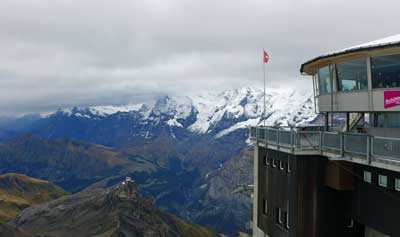
There is a rotating restaurant (with prices similar to normal Swiss restaurants) and a bizarre and anachronistic James Bond attraction based on it being a key location in the 1969 movie On Her Majesty’s Secret Service. The Bond thing is included with the lift, and it’s worth a look.
But the main thing you come here for is the 360-degree view from one of the highest peaks in Europe. Again, the weather here is key, but fortunately all the locals track the visibility on a minute-by-minute basis. If it’s clear up top while you are in the area, it would be a terrible shame to skip it based on the high price. But even if it’s cloudy up top, there are still plenty of wonderful things to see and do in the villages below.
Jungfraujoch observation area
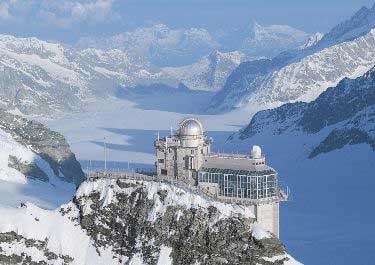
The views from the top are similar to the views from Schilthorn, from the other side of the Lauterbrunnen Valley. Once on top you can have lunch, hike, or even go sledding. It’s also quite expensive at nearly US$200 round-trip unless you have a Swiss Pass or a Eurail Pass for discounts, and it takes most of your day, but you’ll never forget the views from the top.
Harder Kulm mountain and Two Lakes Bridge Observation Deck
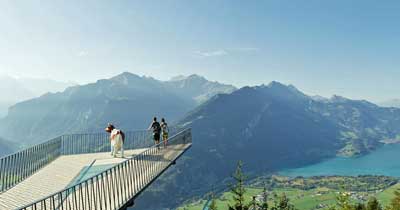
There’s a revolving restaurant about 10 minutes’ walk from the station at the top, which is definitely an unforgettable place for lunch if you’ve got time. It’s not as expensive as you might expect, at least compared to normal restaurants in Switzerland.
The Harder Kulm Railway goes from early April through late November each year. If you are only in Interlaken for one day and/or you are on a strict budget, this is the fastest and best way to get amazing Alpine views in the area.
Getting from Interlaken to Gimmelwald and Mürren
Getting up to these villages sounds complicated and time consuming, but it’s actually fast and easy once you get there. This little guide should help.
Arrive in Interlaken
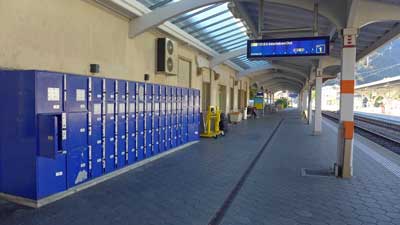
Once you arrive at the Interlaken Ost train station, head for the ticket windows in the office and buy a ticket to your final destination (Lauterbrunnen, Gimmelwald, or Mürren). Eurail passes are good for 25% discounts on the rest of the trip, but not for the whole thing.
From Interlaken Ost to Lauterbrunnen
The private train leaves Interlaken Ost every 30 minutes and arrives in Lauterbrunnen 20 minutes later. If you are staying in Lauterbrunnen then you are probably walking distance from your hotel when you reach the station.
From Lauterbrunnen to Gimmelwald
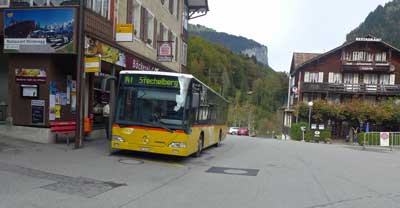
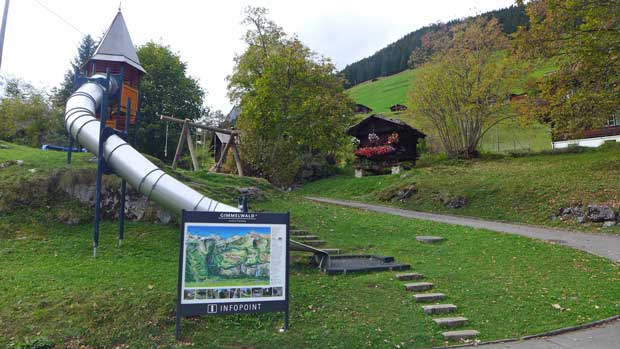
From
Gimmelwald to Mürren
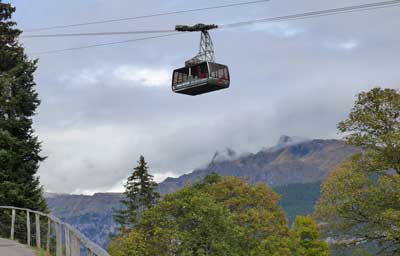
Recommended hotel and hostel in Gimmelwald
I get asked all the time about where to stay in Gimmelwald, so here it is:
Hotel: Esther’s Guesthouse
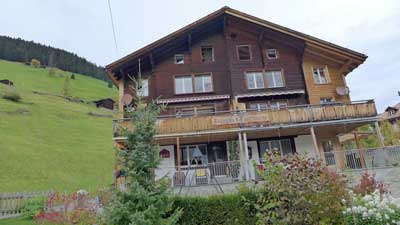
It’s run by Esther, as you might guess, and she is very friendly speaking excellent English. Each room is different and the place feels like a mountain cabin, because it is. She offers an excellent buffet breakfast in the morning, which you have to order the night before. It’s not cheap, but it’s worth it because it’s hearty and there are no other good options nearby.
Book as early as possible because this place is often the first place to sell out in Gimmelwald.
Hostel: Mountain Hostel Gimmelwald
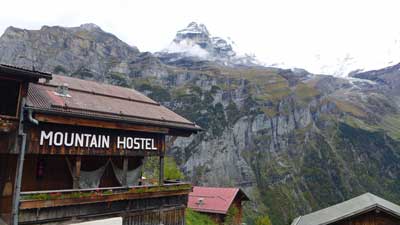
You won’t believe the views from this place, which are the same as from Esther’s except a bit lower and more unobstructed. This place also has a busy bar and restaurant that is basically the only “nightlife” in Gimmelwald. Many hikers get to bed early in this tiny village, but if you want to have a couple drinks and order a pizza or some local options, this is the place to go.
Again, book early because this place is always sold out.
Lucerne and what to do there
Luzern, as it’s spelled locally, is the other traditional holiday destination in Switzerland. Unlike Interlaken, Lucerne actually qualifies as a small city rather than a small resort town, so it’s a very nice contrast and very worthwhile.
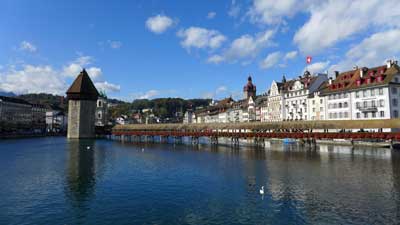
However, unlike Interlaken, the town of Lucerne itself is a great attraction and worth at least a day of exploration. This has always been a rich area so you can expect to find all of the high-end shops and boutiques along the small streets just north of the lake, but there are also many traditional shops and things to see that will appeal to anyone.
Recommended hotel in Lucerne
>>Hotel Des Alpes (3 stars with an amazing location and view)
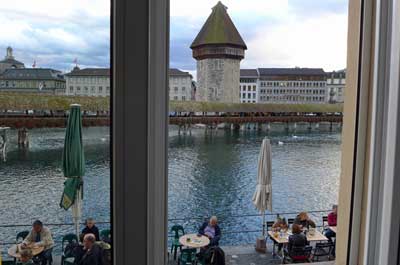
If this place is booked, which is often the case, then book a hotel as close to it as you can find or afford. The whole historic part of town surrounding it is lovely, with restaurants, bars, and high-end shops. There are also a couple of nearby supermarkets where you can buy inexpensive alcohol and picnic supplies to keep other costs down.
Spend a day in Lucerne itself
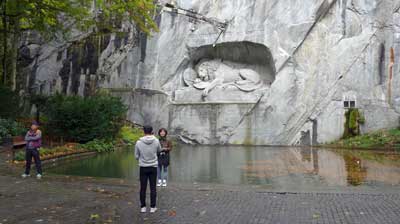
Most of the interesting part of Lucerne is in the area behind those restaurants, and it’s certainly worth doing a self-guided walking tour if not a guided one. Heading farther east you’ll come to another older part of town where the famous lion statue is located. You can’t visit Lucerne without having a look at the lion, and fortunately it’s easy and quick to reach (and it’s free).
Take a lake cruise of some kind
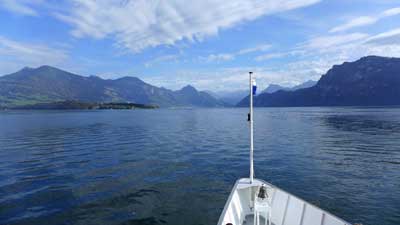
Especially in nice weather, even the short lake tour is lovely, and if you have more time you can jump off at Vitznau and do the scenic hike up Mount Rigi. There are also small lakeside villages that are ideal for a stroll and lunch stop. Long story short, there are dozens of interesting sightseeing options that are available using part of the boat tour, and the views all around are wonderful.
Visit Mount Pilatus
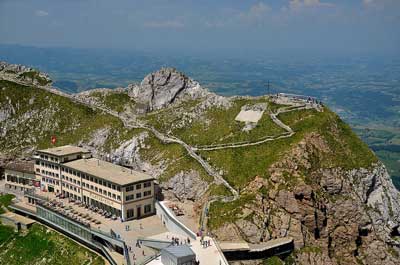
You can take the cogwheel train up and have a more or less flat hike around the summit area, and then take the gondola and cable car back down again. You can do them in the other order, and the cost is the same either way. At around US$65, this is not a cheap hike, but like most everything in Switzerland, the quality is high so it doesn’t feel like a rip-off. You can reach the cable car in 10 minutes on a public trolly bus from Lucerne.
Visit Mount Rigi
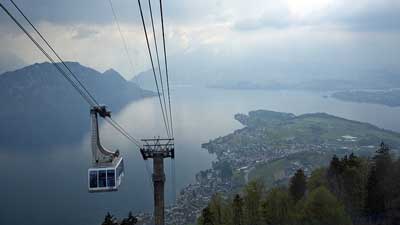
Unlike the other peaks mentioned in this article the Swiss Travel Pass covers both ways to get up and down for free. The others are 50% off with the Swiss Travel Pass or Half Fare Card, except for Jungfraujoch, which is only 25% off with the Swiss Travel Pass and still 50% off with the Half Fare Card.
Visit Mount Titlis
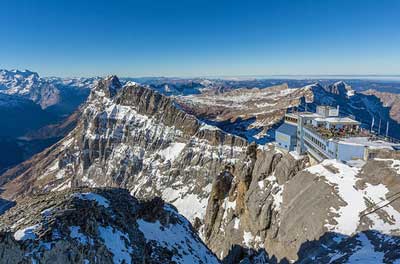
You can reach Titlis by taking a 43-minute train ride from Lucerne to Engelburg and then taking the cable car up from there. As with the others, it’s wise to check the weather immediately before you are going to depart because it can be foggy or cloudy any time of the year, but usually not for whole days at a time.
Additional photo credits
Jungfraujoch by cupweuro on Flickr, Pilatus by Tony Fernandez on Flickr, Rigi by Kosala Bandara on Flickr, Titlis by PaulSchliebs on Flickr

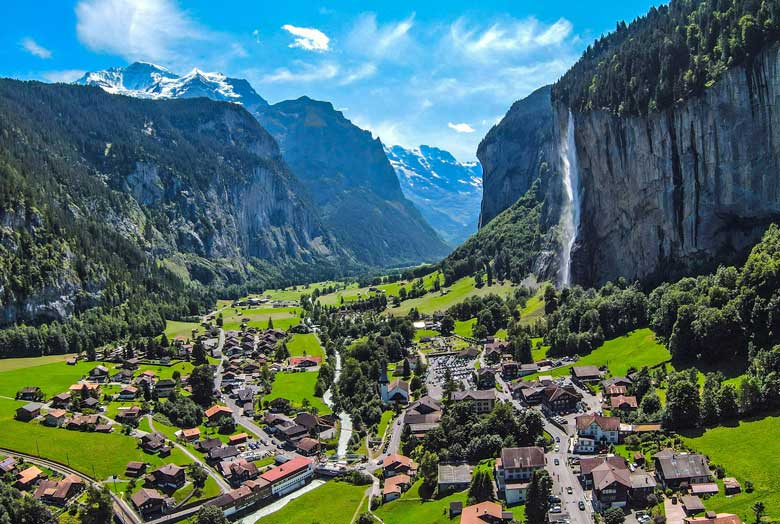
Dear Roger, thanks for all the wonderful information provided above. I plan to visit Switzerland from July 28th to 1st of August. Me, wife and three kids aged 17,12 and 6 years. Am trying to plan as per your suggestions above. We are reaching from Paris by train to Basel. Am thinking of heading by train to Lucerne spending the night and 29th night. Then move on to Interlaken on 30th and stay at Interlaken itself commuting to various mounts etc. We will leave on 2nd August morning for Europa Park in Rust / Germany. Could you please suggest a more personalized plan keeping in view the youngest member of the family. And is it possible to include a visit to the chocolate factory staying in interlaken ? Please also suggest most suitable rail passes . Thanks
Ahmad,
I won’t be much help on this, unfortunately. I’m not aware of a chocolate factory near Interlaken, though there might be one as there are quite a few chocolate-oriented attractions in Switzerland.
Your plan sounds quite good as it is, and I think the 6-year-old will be entertained by just the scenery and walks. It’s really a stunning place and you’ll be on the move a lot, so it’s not like dragging a bored child through an art museum.
You should buy your train ticket from Paris to Basel as soon as possible for the lowest fare. But once you get into Switzerland, the train tickets are always the same price no matter when you buy, so you can just buy them once you get there. They aren’t too expensive either because the distances are fairly short. Have a great trip. -Roger
Thanks Roger. This is the best and most informative page regarding a switzerland visit. One can probably get all the information going through the article and the following posts. Great job.
Can mount titlis be visited as a half day activity ? Can one arrange tickets etc on his own or it is a must to arrange / purchase a tour ? We will reach Lucerne in the evening (5-6pm) from Paris. If we can visit Mt Titlis next day and return to spend the remaining half day in Lucerne itself. Will it be too much ? We can spend the following morning as well in Lucerne before leaving for Interlaken. Interlaken area has been planned as per your suggestions in the article and following posts. Lastly how early one can start to visit Mt Titlis ?
Ahmad,
If you are going to do the cable car to Mt Titlis or something along those lines, you’ll want to allow about 6 hours for your visit after leaving Lucerne. You should be able to plan and book everything you need on travel day with no problem. Fortunately, Switzerland has fixed prices for domestic train tickets and all of the cable cars, so you can buy everything there on the day. Also, most of the trains and attractions are all connected to the same national system, so you might be able to buy all of your tickets at the Lucerne train station. The clerks all speak fluent English, so it’s an easy country to travel in, more so than most of its neighbors.
The first train from Lucerne to Engelberg (base of Titlis) is at 05:05 every morning. After that one, they leave at 10 minutes after the hour starting at 06:10, and the journey takes 43 minutes on a direct train. Let me know if you have any other questions. -Roger
Thanks Roger for the quick response. Will follow your advice. Keep up the excellent job.
Hi Roger,
I plan to go to Switzerland with my parents from 21st to 27th June arriving in Zurich. But my mom cannot walk much. Just wondering whether there are taxis available at Gimmelwald to take us from the cable car to the hotel? If not, then may be I will stay at Lauterbrunnen or Murren. Can we get taxis in either of these places for local transportation from hotel to train/cable station ?
Also, which region would be the best to see snow during that time. We are not really thinking of any snow activities but just being able to get into the snow and play with snow balls 🙂 We can do this in Jungfraujoch, right ?
Your early response would be greatly appreciated.
Deblina,
The only vehicles in Gimmelwald are tractors and small carts used by local farmers. The village is literally just about 10 small hotels, a few restaurants, and about 30 or 40 farms. That’s what makes it so magical. However, Esther’s Guesthouse and the Mountain Hostel are both about 50 meters from the cable car stop, and a few other hotels are in that same area.
Murren is far larger, but also car-free so you’d also need to choose a hotel very close to the cable car stop. Lauterbrunnen is on the valley floor so it’s connected by road to everything else, and there are taxis. If you can book into one of the Gimmelwald or Murren hotels that are next to the cable car stop, there would be almost no walking involved.
In June there will be no snow in Gimmelwald or Murren or anywhere else except the mountaintops. But yes, there will be snow on Jungfraujoch and possibly on Schilthorn as well. Those are your only real hopes for snowballs. Have a great trip and let me know if you have other questions. -Roger
Hi Roger,
I am planning a trip to Switzerland in Sep/Oct for 8 nights. I am traveling with my wife and my three year old kiddo. I will be arriving at Zurich and stay there for a night and take train to Lucerne the next day. My high level itinerary looks as follows:
Lucerne (4 nights) will cover Bern (one day trip from Lucerne), Mt.
Titlis through cable car, Mt. Rigi or Mt. Pilatus, The Lake etc.
Interlaken (3 nights) Gimmelwald or Murren , Some Adventure Sports ,Ballenberg – http://www.ballenberg.ch and jungfraujoch etc.
Then I am planning to take the train from interlaken to Milan (Italy).
Can you please help fine tune my itinerary. Which glaciers shall I prefer Titlis or jungfraujoch?
I am also confused, where shall I spend more time. Lucerne or Interlaken?
Can I skip Zermatt, or shall I visit there even if I am spending quite a few time in Interlaken and LucernE?
Thanks,
subhash
Subhash,
I think your current plan looks quite good. Jungfraujoch is the most dramatic of the high-altitude sights, and Schilthorn is another very popular stop, partly because it’s so easy to reach compared to the others.
Interlaken is home to most of the Alps’ best sightseeing and I would probably spend more time there than in Lucerne, but they are very different so it’s hard to compare. At least one or two nights in Gimmelwald (or Murren) is something kind of magical, yet the city of Lucerne is nicer and more interesting than the town of Interlaken itself. Also, you can reach Bern in about an hour by train from either one, so you can do that day trip at any point of your visit.
In other words, I think you’ll be really impressed and really happy at all points on your trip, and you definitely won’t have time to get bored in any of the stops.
As for Zermatt, you can skip it on this trip without guilt. It does have that famous view of the Matterhorn, but it’s fairly remote and hard to reach, and aside from that view it’s mostly a winter-sports town rather than a sightseeing town. Once you see the views from Interlaken and Lucerne, you’ll be satisfied that you’ve seen the best of the Alps. Have a great trip. -Roger
Thanks Roger.
Since I am staying in Switzerland for 8 days and returning on 9th day. So I am now a bit confused on Swiss Passes. Shall I buy 8 days Swiss Pass ? I understand that some hotels in (Wilderswil) do provide passes which enable you to use all the public transport in the region for free.
Do we also get similar passes in Lucerne area? Can you suggest me the passes, which I should buy which will be most economical for my family (wife and kid.
Thanks,
Subhash
Subhash,
As I’ve mentioned before, the Swiss Passes are confusing and you really have to know which expensive trains and museums and such you want to do in order to know whether it will save you money. In other words, the Swiss Passes are quite expensive, so they will only save money for people who plan on really doing all the expensive rides and things that are included.
I’m not sure about all of the Wilderswil area, but I do know that ALL hotels and hostels in Interlaken include a free public transport pass that is good on the local buses as well as the trains between the two train stations in town.
There is no transport card included for Lucerne hotels, but as long as you stay reasonably close to the train station, which is directly across from where the lake boats leave, you can walk everywhere. And of course you will visit nearby towns on the regular boats more easily than buses. Sorry I couldn’t be of more help on this. -Roger
Thanks Roger.
Now probably the last question. I generally read that Switzerland is pretty safe country for tourists. Just need a bit of more feedback about the crime in general for tourists? Do we have to avoid certain areas in Lucerne or Interlaken during night? or we should play little safe during night travel or pub crawling? How is these places as far as mugging or any petty crime against tourists?
Subhash,
All of Europe is possibly the safest region in the world, and Switzerland is definitely one of its safer countries. There are some junkies who wander around in the areas near the train stations in the cities (although probably not in Interlaken because it’s a quiet town), but they won’t bother you. Pickpocketing is Europe’s main nuisance crime, and you should always take precautions for that, but it’s far more common in Spain and Italy than in Switzerland. Long story short, nothing to worry about at all. Have a great trip. -Roger
Thanks a lot, Roger. This really helps. So, here is the travel plan I am making. Since I will be with my parents, I have to make things really slow so that they get ample rest. I plan to arrive at Zurich on 21st afternoon. stay the night at Zurich. Go to Gimmelwald on 22nd. go to Jungfraujoch on 23rd. 24th rest. 25th go to Schilthorn. 26th return to Zurich. 27th flight back from Zurich.I had a few qs
1> which pass should I take, we will be 3 people
2> In June though there will be no snow, its still recommended to stay at Gimmelwald instead of Lauterbrunnen, right ?
3> Are there hotels in Jungfraujoch region where we can stay overnight and enjoy the snow ?
4> Do you have any suggestions of things to do in the evening in Zurich on 26th June
Deblina,
1. I find the Swiss Travel Passes to be just as confusing as everyone else does. They are good for free train travel and free museum visits, and 50% discounts on the tourist trains and cable cars. I think if a visitor plans on taking several of the longer train trips and also visiting at least a few of the included museums and such, the pass can pay off. But in your case it doesn’t look like you’ll be doing too many train rides, so the 50% discounts might not be worth the price of the pass. Again, it’s very confusing and I think you have to just add up all of your planned expenses to check.
2. Yes, stay in Gimmelwald if you can. It’s definitely nicer there without snow on the ground, in fact. When you arrive on the cable car you’ll be in this dream-like setting of gorgeous green pastures surrounded by surreal views.
3. I don’t believe there are any hotels near the top of Jungfraujoch, but there are some in Kleine Scheidegg, which is where the train trip begins. Honestly, the views from anywhere in that area are amazing, so it may not be worth it to spend a lot more for a special hotel.
4. There are some really nice views along the river in Zurich, and especially along the lake front. At that time of year you’ll have no problem finding things to see and do there by just walking around. Zurich is a really nice city, even though it lacks major sights and it’s quite expensive. -Roger
thanks Roger. Just wondering. Is it worthwhile to go to both Schilthorn and Jungfraujoch ? or both are very similar and going to just one is recommended ?
Deblina,
They are both the absolute best panoramic views of the top of the Alps, but from different peaks. If you have time (and money) to do both, it’s recommended. Shilthorn is about an hour up from Lauterbrunnen and Gimmelwald by cable car, and then there is the 360-degree revolving restaurant on top (with normal Swiss prices, by the way) and the James Bond attraction. The Jungfraujoch is a 2.5-hour train ride that can be cold, to the highest station in Europe, also with a restaurant and observation deck. Shilthorn can be done in 3 hours or so, where Jungfraujoch takes most of a day. -Roger
Hi Roger,
I decided to stay at Murren. Just wondering, can we buy tickets to Scilthorn and Jungfrauch from Murren cable car station or somewhere else in Murren, the same morning that we intend to travel ? Also is it recommended to reserve train seats for Jungfrauch or generally seats will be available in June end? Moreover, can we also buy train tickets back to Zurich from Murren ?
Deblina,
I’m 99% sure that all of those ticket booths are hooked into the main national SBB system, so you should be able to buy any ticket at any of them. I’m 100% sure you can buy Schilthorn tickets in Murren, because that’s the main stop in the middle of the cable car system on the way there.
I don’t know about reserved seats on the Jungfraujoch train. Many people book at the last minute because they want to make sure the weather is okay. Sometimes it can be foggy or cloudy up there, but not too often in summer. So my guess would be that you’d have no problem buying tickets, but I’m not 100% sure.
And again, I suspect you can buy tickets to Zurich in Murren, but at the very least you can buy tickets from there back to the nearest train station in Lauterbrunnen, and then get tickets there to Zurich. They are very professional and well run, so it’s unlikely that you’d find long queues, so you can just buy tickets as you go if you like. Have a great trip. -Roger
Hi Roger,
your write up about Swiss travel is excellent! I needed some advice,hope you will guide me.
We(me,wife&2 kids) are planning a trip to Paris and Switzerland. we will be flying from SFO to Paris in first week of July. We will be in Paris for 2 nights.We are going to be in Switzerland for 4 days.We definitely wants to see Interlaken, Lucerne and may be Bern(my daughter wants to get a feel for the Swiss culture.We will be flying out from Geneva. So can you help me planning a itenary.
Mona.
Mona,
Thank you, and I’ll try to help. Two nights in Paris is a very quick trip and if you haven’t been there before, I’d actually recommend staying longer if possible.
As far as 4 days in Switzerland, I’d recommend going to Interlaken for 3 nights and then 1 night in Lucerne. You can visit them in either order. And if you prefer you can do 2 nights in each, but if you want to visit Bern (definitely a highlight) then you can do it as a day trip from Interlaken. The train takes about an hour each way, and it only takes about 3 hours to see the main sights in and near the historic center, which is a short walk from the train station. So you could take a train to Bern right after breakfast, then spend 3 or 4 hours in Bern including lunch at one of its many outdoor restaurants, and be back in Interlaken by 3pm, allowing you enough time to still see something else.
In the article above I describe the charms of the mountain towns of Gimmelwald and Murren. I highly recommend staying in one of those for 2 nights, but if you are doing a Bern day trip you might then switch to a hotel near one of the two train stations in Interlaken for the third night. You can get from Interlaken OR from Lucerne directly to the Geneva Airport train station in about 3 hours and the trains start at about 5am, so you could start in Lucerne and then go to Interlaken or the other way around. As always, let me know if you have any other questions. -Roger
Hi!
I’m not a stranger to Switzerland, my mother lived in Luzern. I agree with you that it’s a beautiful city! We want to come for a 2 week vacation in August but we want to stay in an apartment in one place. the most important part I would like to know is which places offer such a card that includes free cable cars. the ones I know of are Davos and Saastal. Any idea which other ones? Thanks!
Helen,
It sounds like you are referring to the Swiss Travel Pass, which includes free rides on some cable cars and 50% discounts on others. It’s a confusing pass and I’m not an expert on it, so you are best off reading about it on the official website for it.
I believe the popular cable cars in the Interlaken and Luzern areas are mostly the 50% discount ones, or at least the highest altitude sections are. Sorry I couldn’t be of more help. Let me know if you have any other questions and I’ll take a shot. -Roger
Hi Roger,
Since I did not find a thread on the Bruges/Brussels page, I will post a query here.
How much time do you think is required to see Bruges.
Do you think the canal boat ride in Bruges is worth it?
Heard that Bruges looks surreal in the evening, when the day tourists have left. Any opinion on that?
Is a stop over at Brussels while travelling from Paris to Bruges to visit the Grand Place a good idea?
Many thanks,
Judhajit
Judhajit,
For non-Switzerland questions it’s probably best to ask them below this article about Europe itinerary planning. But I’ll handle this one here.
Bruges is a fairly compact town and two nights should be enough, or even one night if you give yourself around 24 hours. It’s nice at night, but I don’t remember it being unusually nice. It probably is a bit less crowded at night because some people do visit it on bus tours, but there are loads of hotels and hostels in Bruges so it’s not too quiet at night.
As I’ve written elsewhere, I do think that stopping for 2 to 6 hours in Brussels on the way to Bruges is a great idea. The main square (Grand Place) is one of the most beautiful in Europe, and the historic center is worth a look and maybe a lunch stop. Aside from that, Brussels is really built for business travelers and bureaucrats so prices are high and many things seem generic. -Roger
Roger,
Do have the same opinion about Thun as Spiez. These places have small castles and looked interesting, so I thought of giving them a visit. Would you then recommend not to get off anywhere during the Thun lake cruise or just skip the lake cruise at Thun/Brienz?
Thanks
Judhajit,
I haven’t done a Thun cruise so it’s hard for me to say. The whole area is absolutely gorgeous and I don’t think you need to see it from the lake, but if you did it I imagine you’d enjoy it. What I’d recommend is to see what it all looks like when you get there and then do whatever appeals to you at the moment. You’ve done 90% of the planning already, from the sound of it, and you can give yourself some options to choose from on the spot. I also love travel planning, so I’m right there with you. -Roger
Roger,
As I am tinkering around with my itinerary, I come up with another question. Please tell me if the following activities are possible to do in a single day:-
Check out from hotel in Lucern – Travel Interlaken to Lucern by train – check into hotel at Interlaken – Lake Thun cruise on way – Explore Thun on foot – Take train to Spiez – Wander around Spiez – Train back to Interlaken
Thanks
Judhajit,
I’d say it’s possible to do all of that in one day as long as you start early and as long as the hotel in Interlaken you are checking into is near one of the train stations (all trains stop at both stations). But I don’t know if the Spiez trip is something I’d recommend unless you have at least a week in Switzerland. It’s a nice looking little town for sure, but without any real attractions that I’m aware of. You could have as much enjoyment out of walking around Interlaken or Lauterbrunnen or Wengen or many others that you’ll be going through already. -Roger
Hi Roger,
We’re planning on traveling from Paris to Italy via Switzerland in September and will be staying just 2 nights. Hoping to not spend the whole time in the car. Where would you recommend which isn’t too far off the beaten track which is still very beautiful to stay and explore a little? We will be coming into Switzerland by rail and leaving by car.
Jo,
The most amazing place to experience the wonders of Swiss scenery is the area in and just above Interlaken. Lucerne is also nice, but if I only had 2 days in the country I’d go to the Interlaken area every time. It’s on one of the main train lines so it’s easy to get in and out, unlike some of the other scenic areas such as Zermatt. Have a close look at the specific advice in the article above, and if you can get a reservation in the tiny town of Gimmelwald, that is the single best place. Bon voyage. -Roger
Hi, I am back again with questions.
Tell me about Coop supermarket in Switzerland. Read it is a good place to pick up stuff for cheap meals. Your experience?
Thanks
JUDHAJIT,
Yes, Coop is a full-size supermarket with reasonable prices. There is a location just steps from the Interlaken Ost train station and another one inside the Lucerne train station. Food prices will seem low compared to restaurant prices, but high compared to supermarkets in other countries. -Roger
I was just wondering if, instead of the Jungfrau trip, I just visit Wengen, Lauterbrunnen, Grutschalp, Gimmelwald, Stechelberg and Murren in a day. That would be much economical and would also let me get a good fell of the alpine region.
Lauterbrunnen and Wengen is on the Jungfrau route. Howerver, I cannot understand which route to follow to cover the remaining places. Which site do I use to find connections and ticket fares? I tried the SBB and Jungfrau sites but it is not clear.
Regards
JUDHAJIT,
You are going past my knowledge of the area, so I am not of much help with this. I didn’t do the Jungfraujoch trip when I was there because it’s quite expensive and most people agree that the Schilthorn is the more amazing of the two. I spoke to a few people who did both and they agreed that Schilthorn is the one to do if you are only going to do one. So I instead took a train from Lauterbrunnen to Wengen and then up the cable car on the other side of town, to do one of the famous mountain hikes. It was fantastic, with great views of the main peaks, and it cost something like US$20 in total.
When you get to that area you’ll find that the views are wonderful no matter which way you look, so I think you’ll be happy with whatever you decide. -Roger